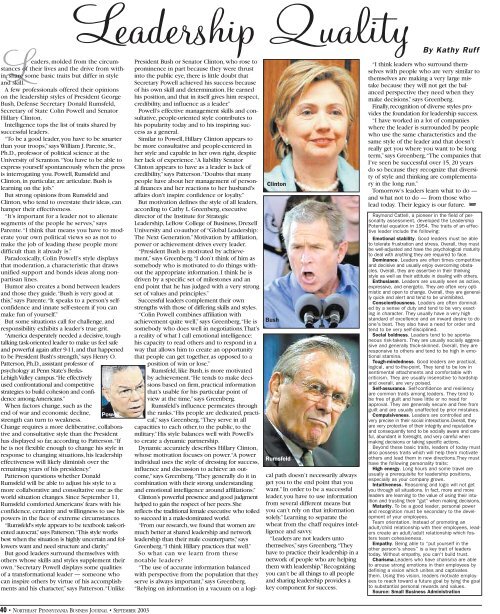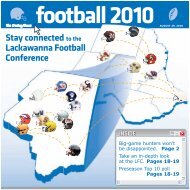racetracks
I want to be left alone! - The Times-Tribune
I want to be left alone! - The Times-Tribune
- No tags were found...
You also want an ePaper? Increase the reach of your titles
YUMPU automatically turns print PDFs into web optimized ePapers that Google loves.
40 • NORTHEAST PENNSYLVANIA BUSINESS JOURNAL • SEPTEMBER 2003<br />
Leaders, molded from the circumstances<br />
of their lives and the drive from within,<br />
share some basic traits but differ in style<br />
and skill.<br />
A few professionals offered their opinions<br />
on the leadership styles of President George<br />
Bush, Defense Secretary Donald Rumsfeld,<br />
Secretary of State Colin Powell and Senator<br />
Hillary Clinton.<br />
Intelligence tops the list of traits shared by<br />
successful leaders.<br />
“To be a good leader, you have to be smarter<br />
than your troops,” says William J. Parente, Sr.,<br />
Ph.D., professor of political science at the<br />
University of Scranton.“You have to be able to<br />
express yourself spontaneously when the press<br />
is interrogating you. Powell, Rumsfeld and<br />
Clinton, in particular, are articulate. Bush is<br />
learning on the job.”<br />
But strong opinions from Rumsfeld and<br />
Clinton, who tend to overstate their ideas, can<br />
hamper their effectiveness.<br />
“It’s important for a leader not to alienate<br />
segments of the people he serves,” says<br />
Parente.“I think that means you have to moderate<br />
your own political views so as not to<br />
make the job of leading these people more<br />
difficult than it already is.”<br />
Paradoxically, Colin Powell’s style displays<br />
that moderation, a characteristic that draws<br />
unified support and bonds ideas along nonpartisan<br />
lines.<br />
Humor also creates a bond between leaders<br />
and those they guide.“Bush is very good at<br />
this,” says Parente.“It speaks to a person's selfconfidence<br />
and innate self-esteem if you can<br />
make fun of yourself.”<br />
But some situations call for challenge, and<br />
responsibility exhibits a leader’s true grit.<br />
“America desperately needed a decisive,toughtalking<br />
task-oriented leader to make us feel safe<br />
and powerful again after 9-11,and that happened<br />
to be President Bush's strength,”says Henry O.<br />
Patterson,Ph.D.,assistant professor of<br />
psychology at Penn State’s Berks-<br />
Lehigh Valley campus.“He effectively<br />
used confrontational and competitive<br />
strategies to build cohesion and confidence<br />
among Americans.”<br />
When factors change, such as the<br />
end of war and economic decline,<br />
strength can turn to weakness.<br />
Change requires a more deliberative, collaborative<br />
and consultative style than the President<br />
has displayed so far, according to Patterson.“If<br />
he is not flexible enough to change his style in<br />
response to changing situations, his leadership<br />
effectiveness will likely diminish over the<br />
remaining years of his presidency.”<br />
Patterson questions whether Donald<br />
Rumsfeld will be able to adjust his style to a<br />
more collaborative and consultative one as the<br />
world situation changes. Since September 11,<br />
Rumsfeld comforted Americans’ fears with his<br />
confidence, certainty and willingness to use his<br />
powers in the face of extreme circumstances.<br />
“Rumsfeld's style appears to be textbook task-oriented<br />
autocrat,”says Patterson.“This style works<br />
best when the situation is highly uncertain and followers<br />
want and need structure and clarity.”<br />
But good leaders surround themselves with<br />
others whose skills and styles supplement their<br />
own.“Secretary Powell displays some qualities<br />
of a transformational leader — someone who<br />
can inspire others by virtue of his accomplishments<br />
and his character,” says Patterson.“Unlike<br />
Leadership Quality<br />
Powell<br />
Clinton<br />
Bush<br />
Rumsfeld<br />
President Bush or Senator Clinton, who rose to<br />
prominence in part because they were thrust<br />
into the public eye, there is little doubt that<br />
Secretary Powell achieved his success because<br />
of his own skill and determination. He earned<br />
his position, and that in itself gives him respect,<br />
credibility, and influence as a leader.”<br />
Powell’s effective management skills and consultative,<br />
people-oriented style contributes to<br />
his popularity today and to his inspiring success<br />
as a general.<br />
Similar to Powell, Hillary Clinton appears to<br />
be more consultative and people-centered in<br />
her style and capable in her own right, despite<br />
her lack of experience.“A liability Senator<br />
Clinton appears to have as a leader is lack of<br />
credibility,” says Patterson.“Doubts that many<br />
people have about her management of personal<br />
finances and her reactions to her husband's<br />
affairs don't inspire confidence or loyalty.”<br />
But motivation defines the style of all leaders,<br />
according to Cathy L. Greenberg, executive<br />
director of the Institute for Strategic<br />
Leadership, LeBow College of Business, Drexell<br />
University and co-author of “Global Leadership:<br />
The Next Generation.” Motivation by affiliation,<br />
power or achievement drives every leader.<br />
“President Bush is motivated by achievement,”<br />
says Greenberg.“I don’t think of him as<br />
somebody who is motivated to do things without<br />
the appropriate information. I think he is<br />
driven by a specific set of milestones and an<br />
end point that he has judged with a very strong<br />
set of values and principles.”<br />
Successful leaders complement their own<br />
strengths with those of differing skills and styles.<br />
“Colin Powell combines affiliation with<br />
achievement quite well,” says Greenberg.“He is<br />
somebody who does well in negotiations.That’s<br />
a reality of what I call emotional intelligence:<br />
his capacity to read others and to respond in a<br />
way that allows him to create an opportunity<br />
that people can get together, as opposed to a<br />
position of win or lose.”<br />
Rumsfeld, like Bush, is more motivated<br />
by achievement.“He tends to make decisions<br />
based on firm, practical information<br />
that’s usable for his particular point of<br />
view at the time,” says Greenberg.<br />
Rumsfeld’s influence permeates through<br />
the ranks.“His people are dedicated, practical,”<br />
says Greenberg.“They serve in all<br />
capacities to each other, to the public, to the<br />
military.” His style balances well with Powell’s<br />
to create a dynamic partnership.<br />
Dynamic accurately describes Hillary Clinton,<br />
whose motivation focuses on power.“A power<br />
individual uses the style of dressing for success,<br />
influence and discussion to achieve an outcome,”<br />
says Greenberg.“They generally do it in<br />
combination with their strong understanding<br />
and emotional intelligence around affiliations.”<br />
Clinton’s powerful presence and good judgment<br />
helped to gain the respect of her peers.She<br />
reflects the traditional female executive who toiled<br />
to succeed in a male-dominated world.<br />
“From our research,we found that women are<br />
much better at shared leadership and network<br />
leadership than their male counterparts,”says<br />
Greenberg.“I think Hillary practices that well.”<br />
So what can we learn from these<br />
notable leaders?<br />
“The use of accurate information balanced<br />
with perspective from the population that they<br />
serve is always important,” says Greenberg.<br />
“Relying on information in a vacuum on a logical<br />
path doesn’t necessarily always<br />
get you to the end point that you<br />
want.” In order to be a successful<br />
leader, you have to use information<br />
from several different means but<br />
you can’t rely on that information<br />
solely.” Learning to separate the<br />
wheat from the chaff requires intelligence<br />
and savvy.<br />
“Leaders are not leaders unto<br />
themselves,”says Greenberg.“They<br />
have to practice their leadership in a<br />
network of people who are helping<br />
them with leadership.”Recognizing<br />
you can’t be all things to all people<br />
and sharing leadership provides a<br />
key component for success.<br />
By Kathy Ruff<br />
“I think leaders who surround themselves<br />
with people who are very similar to<br />
themselves are making a very large mistake<br />
because they will not get the balanced<br />
perspective they need when they<br />
make decisions,” says Greenberg.<br />
Finally,recognition of diverse styles provides<br />
the foundation for leadership success.<br />
“I have worked in a lot of companies<br />
where the leader is surrounded by people<br />
who use the same characteristics and the<br />
same style of the leader and that doesn’t<br />
really get you where you want to be long<br />
term,” says Greenberg.“The companies that<br />
I’ve seen be successful over 15, 20 years<br />
do so because they recognize that diversity<br />
of style and thinking are complementary<br />
in the long run.”<br />
Tomorrow’s leaders learn what to do —<br />
and what not to do — from those who<br />
lead today. Their legacy is our future.<br />
Raymond Cattell, a pioneer in the field of personality<br />
assessment, developed the Leadership<br />
Potential equation in 1954. The traits of an effective<br />
leader include the following:<br />
Emotional stability. Good leaders must be able<br />
to tolerate frustration and stress. Overall, they must<br />
be well-adjusted and have the psychological maturity<br />
to deal with anything they are required to face.<br />
Dominance. Leaders are often times competitive<br />
and decisive and usually enjoy overcoming obstacles.<br />
Overall, they are assertive in their thinking<br />
style as well as their attitude in dealing with others.<br />
Enthusiasm. Leaders are usually seen as active,<br />
expressive, and energetic. They are often very optimistic<br />
and open to change. Overall, they are generally<br />
quick and alert and tend to be uninhibited.<br />
Conscientiousness. Leaders are often dominated<br />
by a sense of duty and tend to be very exacting<br />
in character. They usually have a very high<br />
standard of excellence and an inward desire to do<br />
one's best. They also have a need for order and<br />
tend to be very self-disciplined.<br />
Social boldness. Leaders tend to be spontaneous<br />
risk-takers. They are usually socially aggressive<br />
and generally thick-skinned. Overall, they are<br />
responsive to others and tend to be high in emotional<br />
stamina.<br />
Tough-mindedness. Good leaders are practical,<br />
logical, and to-the-point. They tend to be low in<br />
sentimental attachments and comfortable with<br />
criticism. They are usually insensitive to hardship<br />
and overall, are very poised.<br />
Self-assurance. Self-confidence and resiliency<br />
are common traits among leaders. They tend to<br />
be free of guilt and have little or no need for<br />
approval. They are generally secure and free from<br />
guilt and are usually unaffected by prior mistakes.<br />
Compulsiveness. Leaders are controlled and<br />
very precise in their social interactions.Overall, they<br />
are very protective of their integrity and reputation<br />
and consequently tend to be socially aware and careful,<br />
abundant in foresight, and very careful when<br />
making decisions or taking specific actions.<br />
Beyond these basic traits, leaders of today must<br />
also possess traits which will help them motivate<br />
others and lead them in new directions.They must<br />
have the following personality traits:<br />
High energy. Long hours and some travel are<br />
usually a prerequisite for leadership positions,<br />
especially as your company grows.<br />
Intuitiveness. Reasoning and logic will not get<br />
you through all situations. In fact, more and more<br />
leaders are learning to the value of using their intuition<br />
and trusting their “gut” when making decisions.<br />
Maturity. To be a good leader, personal power<br />
and recognition must be secondary to the development<br />
of your employees.<br />
Team orientation. Instead of promoting an<br />
adult/child relationship with their employees, leaders<br />
create an adult/adult relationship which fosters<br />
team cohesiveness.<br />
Empathy. Being able to “put yourself in the<br />
other person's shoes” is a key trait of leaders<br />
today. Without empathy, you can't build trust.<br />
Charisma.Leaders who have charisma are able<br />
to arouse strong emotions in their employees by<br />
defining a vision which unites and captivates<br />
them. Using this vision, leaders motivate employees<br />
to reach toward a future goal by tying the goal<br />
to substantial personal rewards and values.<br />
Source: Small Business Administration




